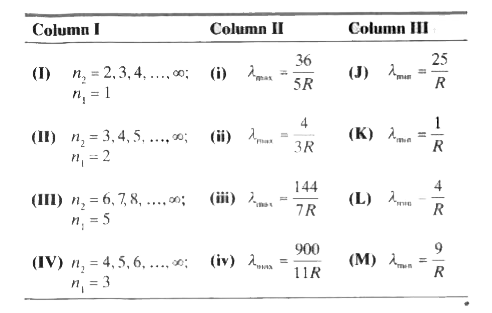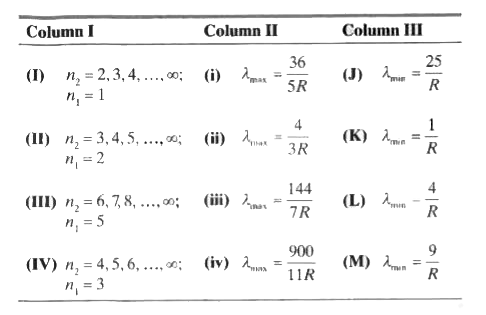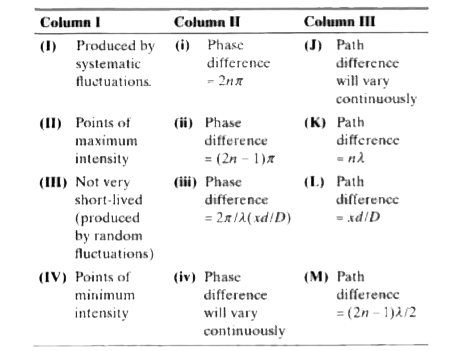The amplitudes of two coherent waves are vector quanti- ties. In the given table, Column I shows the phase differ ence between two coherent waves, Column II shows the path difference between them and Column III shows their resultant amplitudes.

When is ER maximum?
(I) (ii) (M)
(III) (ii) (J)
(II) (ii) (K)
(II) (iv) (M)
The correct Answer is:B
(III) (ii) (J)
Topper's Solved these Questions
- INTERFERENCE AND DIFFRACTION BOOK - RESNICK AND HALLIDAYCHAPTER - INTERFERENCE AND DIFFRACTION EXERCISE - PRACTICE QUESTIONS (Integer Type)
6 Videos
- INTERFERENCE AND DIFFRACTION BOOK - RESNICK AND HALLIDAYCHAPTER - INTERFERENCE AND DIFFRACTION EXERCISE - PRACTICE QUESTIONS (Matrix-Match)
1 Videos
- HYDROGEN ATOMBOOK - RESNICK AND HALLIDAYCHAPTER - HYDROGEN ATOMEXERCISE - PRACTICE QUESTIONS(Integer Type)
6 Videos
- MAGNETIC FIELDS DUE TO CURRENTSBOOK - RESNICK AND HALLIDAYCHAPTER - MAGNETIC FIELDS DUE TO CURRENTSEXERCISE - Practice Question (Integer Type)
4 Videos
Similar Questions
Knowledge Check
The amplitudes of two coherent waves are vector quanti- ties. In the given table, Column I shows the phase differ ence between two coherent waves, Column II shows the path difference between them and Column III shows their resultant amplitudes.

When is the phasor diagram at primary maxima?A(I) (iii) (M)B(III) (ii) (K)C(I) (i) (L)D(I) (iii) (J)The amplitudes of two coherent waves are vector quanti- ties. In the given table, Column I shows the phase differ ence between two coherent waves, Column II shows the path difference between them and Column III shows their resultant amplitudes.

When is the phasor diagram at secondary maxima?A(III) (i) (L)B(IV) (i) (J)C(III) (iv) (J)D(IV) (iv) (M)If two coherent light waves produce minima of fifth order, the path difference between the waves is-
A5λB5λ/2C7λ/2D9λ/2
If the phase difference between the two wave is 2π during superposition, then the resultant amplitude is
View SolutionDifferent hydrogen spectral series have different wave- lengths. In the given table, Column I shows the values of energy levels between which electronic transition takes place, Column II shows the formula of maximum wave- length of different spectral series and Column III shows the formula of minimum wavelength of different spectral series

Determine the wavelengths λmaxandλmin for Pfund series.
View SolutionDifferent hydrogen spectral series have different wave- lengths. In the given table, Column I shows the values of energy levels between which electronic transition takes place, Column II shows the formula of maximum wave- length of different spectral series and Column III shows the formula of minimum wavelength of different spectral series

Determine the wavelength, λmaxandλmin for Paschen series.
View SolutionDifferent hydrogen spectral series have different wave- lengths. In the given table, Column I shows the values of energy levels between which electronic transition takes place, Column II shows the formula of maximum wave- length of different spectral series and Column III shows the formula of minimum wavelength of different spectral series

Determine the wavelengths, λmaxandλmin for Balmer series.
View SolutionInterference is an important property of light. In the given table, Column I shows the properties of interfering waves, Column II shows the phase difference, and Column III shows the path difference between two interfering waves

What are the conditions for constructive interference?
View Solution
